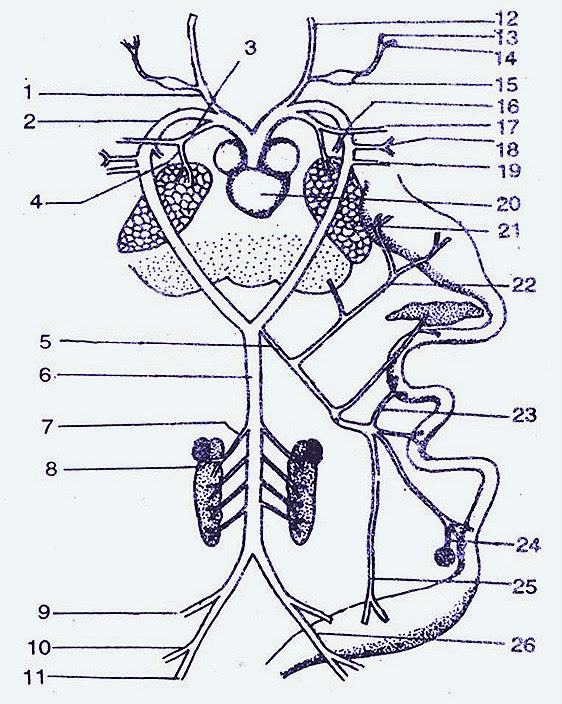ARTERIAL SYSTEM-FISH (SCOLIODON), ARTERIAL SYSTEM-FROG (RANA)-CAMPARISION
ARTERIAL SYSTEM-IN PISCES AND AMPHIBIANS- SIMILARITIES AND DIFFERENCES
Scoliodon( Shark)is a poikilothermic animal. It is a cartilaginous fish .Frog ( Rana) is a cold blooded and amphibious animal. The circulation of blood is carried by closed vessels. The vessels which supply blood to the various organs of the body are known as arteries as the net work of arteries form the Arterial system. The walls of arteries are thick and lumen is narrow. The blood pressure is high in the arteries. Arteries do not possess valves. The arteries end in capillaries. Arteries deeply seated in the body. Mostly arteries contain oxygenated blood. A few arteries also carry deoxygenated blood to the respiratory organs (either gills or lungs) for purification.

|
Scoliodon (fish) |
FROG-RANA |
|
| 1 | The arterial system consists of a ventral aorta, afferent and efferent branchials, dorsal aorta, and its branches and hypobranchials. | 1.The arterial system consists of a truncus arteriosus, three pairs of aortic arches and the dorsal aorta & its branches. |
| 2 | Five pairs afferent branchial arteries are present. | 2 Absent. |
| 3 | Efferent branchial system is associated with gill-slits along with the respective arteries. | 3 Absent. |
| 4 | The arteries to the head are given off from the first pair of epibranchials and by the branches of dorsal aorta carotid labyrinth is absent. | 4.The head is supplied blood by the branches. Carotid arteries arising from the truncus arteriosus. Carotid labyrinth is present, |
| 5 | Parietal arteries are present. | 5. Parietal arteries are absent. |
| 6 | Hypobranchial plexus is present. | 6 It is absent. |
| 7 | Dorsal aorta is formed by the union of epibranchial arteries of both the right and left sides. | 7 The second branches of turncus, the systemic arches of the left and right sides unite to form the dorsal aorta. |
| 8 | Subclavian arteries arise from the dorsal aorta. | 8 Sub clavian artery arises from each systemic arch. |
| 9 | Absent. | 9 Occipito-vertebral artery arises from the systemic arch of each side. |
| 10 | Coeliaco-mesenteric artery arises from behind the union of the four pairs of epibranchials. | 10.Coeliaco-mesenteric artery arises from the junction of the two system¬ic arches. |
| 11 | Just below the Coeliaco-mesenteric artery, lienogastric artery arises. | 11.Lie no gastric artery is absent.. |
| 12 | The parietal artery gives off four pairs renal arteries. | 12.Four pairs of renal arteries arise directly from the dorsal aorta. |
| 13 | Gonadial (Spermatic or ovarian) artery arises from the lieno gastric artery. | 13.Gonadial arteries arise directly from the first pair of renal arteries. |
| 14 | Dorsal aorta terminates into caudal artery. | 14.C-iudal artery is absent |
| 15 | Pulmo cutaneous arch is absent. |
15.The third branch of truncus is the pulmo-cutaneous arch which is divided into pulmonary and cutanecious arteries. |

1. Carotid trunk
2. Systemic trunk
3. Pulmocutaneous
4. Pulmonary artery
5. Coehaco-mesentenc artery
6. Dorsal aorta
7. Renal artery
8. Gonadial artery
9. Vesicuo epigastric artery
10. Femoral artery
11. Sciatic artery
12. External carotid artery
13. Palatine artery
14. Internal carotid artery
15. Carotid labyrinth
16. Oesophageal artery
17. Cutaneous artery
18. Occipito vertebral artery
19. Sub clavian artery
20. Heart
21. Lung
22. Coeliac artery
23. Anterior mesenteric artery
24. Splenic artery
25. Posteior mesenteric artery
26. Iliac artery.
The heart of fish possess venous blood and blood passes through the heart only once in a complete circuit. But in frog the heart receives both oxygenated and venous blood and the circulation is bi circuit.
The fish is an aquatic animal and possesses five pairs of gills. The blood is supplied by pairs of afferent bronchial arteries and is collected by nine pairs of efferent bronchial arteries. In frog however, the respiratory organs are a pair of lungs (skin & buccal cavity also help in respiration) which are supplied by a pair of pulmonary arteries.
